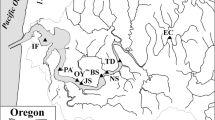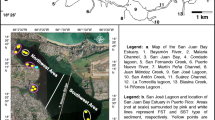Abstract
Nitrification rates, measured in different sediment types from Danish waters, are in the range of 0.3 to 1.4 mmol NO -3 m-2 d-1. There is no signification between sandy and muddy sediments, nor between shallow and deeper stations. The extent of nitrification is probably limited to the zone of oxygen penetration, 1.5 to 5.5 mm. There are, however, nitrifying bacteria located in the anoxic sediment layers. There relative numbers were found by measuring the “nitrification potential” of the sediment. These potential rates (22°C) can also be used to calculate actual rates of nitrification, by adjusting to in situ temperature and oxygen penetration. These calculated rates agree with the actual measured rates of nitrification for a wide range of sediment types and may be used for the estimation of actual nitrification rates. Nitrate flux out from the sediment/water interface is in the range of 0 to 0.7 mmol NO -3 m-2 d-1. There is no correlation between concentration gradients of nitrate across the sediment/water interface and the measured flux of nitrate. Approximately 50% of nitrate production is released to the water column. The remainder (0 to 0.35 mmol N m-2 d-1) may have been denitrified.
Similar content being viewed by others
Literature cited
Armstrong, F. A. J., C. R. Stems and J. D. H. Strickland: The measurement of upwelling and subsequent biological processes by means of the Technicon Auto-analyser and associated equipment. Deep Sea Res. 14, 381–389 (1967)
Billen, G.: Evaluation of nitrifying activity in sediments by dark C-14 bicarbonate incorporation. Water Res. 10, 51–57 (1976)
Hanse, J. I.: Potentiel nitrifikation i marine sedimenter, 73 pp. M.Sc. thesis, Aarhus University, Aarhus, Denmark, 1980
Henriksen, K.: Measurement of in situ rates of nitrification in sediment. Microb. Ecol. (In press)
Henriksen, K., J. I. Hansen and T. H. Blackburn: The influence of benthic infauna on exchange rates of inorganic nitrogen between sediment and water column. Ophelia, suppl. 1, 249–256 (1980)
Jørgensen, B. B.: The sulfur cycle of a coastal marine sediment (Limfjorden, Denmark). Limnol. Oceanogr. 22, 814–832 (1977)
Kanneworf, E. and W. Nicolaisen: The “Haps”, a frame supported bottom corer. Ophelia 10, 119–128 (1973)
Knowles, G., A. L. Downing and M. J. Barret: Determination of kinetic constants for nitrifying bacteria in mixed culture with the aid of an electronic computer. J. Gen. Microbiol. 38, 263–278 (1965)
Payne, W. J.: Reduction of nitrogenous oxides by microorganisms. Bact. Rev. 37, 409–452 (1973)
Revsbech, N. P., B. B. Jørgensen and T. H. Blackburn: Oxygen in the seabottom measured with a microelectrode. Science, N.Y. 207, 1355–1356 (1980)
Solórzano, L.: Determination of ammonia in natural waters by the phenolhypochlorite method. Limnol. Oceanogr. 14, 799–801 (1969)
Steemann-Nielsen, E.: Die Produktionsbedingungen des Phytoplanktons im Übergangsgebiet zwischen der Nord- und Ostsee. Medd. Komm. Danm. Fisk. Havund., phytoplankton (4) 3, 1–55 (1940)
Author information
Authors and Affiliations
Additional information
Communicated by T. Fenchel, Aarhus
Rights and permissions
About this article
Cite this article
Henriksen, K., Hansen, J.I. & Blackburn, T.H. Rates of nitrification, distribution of nitrifying bacteria, and nitrate fluxes in different types of sediment from Danish waters. Mar. Biol. 61, 299–304 (1981). https://doi.org/10.1007/BF00401569
Accepted:
Issue Date:
DOI: https://doi.org/10.1007/BF00401569




